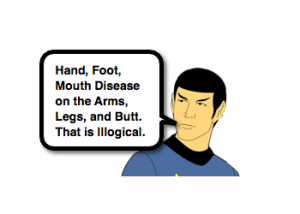Originally published at Pediatric EM Morsels on November 17, 2017. Reposted with permission.
Follow Dr. Sean M. Fox on twitter @PedEMMorsels

Childhood rashes are not my favorite topic or condition to contemplate. I use a rather simplistic approach (see Approach to Rashes) and a little bit of knowledge about typical childhood dermatologic eruptions (ex, Molluscum, Diaper Dermatitis, Perianal Strep, Scabies, Erythema Multiforme). Sometimes, though, things can get a little weird (ex, pyoderma gangrenous). Additionally, the child’s own skin conditions can influence the appearance of typical conditions (like Atopic Dermatitis -> Eczema Herpeticum). Another condition to add to that unique list is Hand Foot Mouth Disease. Let’s look at Severe Hand Foot Mouth Disease:
Hand Foot Mouth Disease: Classic
- Hand Foot Mouth Disease (HFMD) classically is associated w/:
- Stomatitis of the oral mucosa – small vesicles and erosions in the mouth
- Vesicles on the hands, feet, and occasionally the buttocks
- Fever
- Mild gastrointestinal symptoms
- Known sick contracts
- It is associated with enterovirus.
Hand Foot Mouth Disease: Severe
- Severe forms of HFMD have been found to present in atypical fashions. [Mathes, 2013]
- Associated with Coxsackievirus A6
- Occur in outbreaks.
- It can present in 4 other distinct manners: [Mathes, 2013]
- Widespread vesicles, bullae, and erosions that extend beyond palms and soles
- Perioral, acral, and buttock areas are predominant
- Younger children (<1 year) are more likely to have bullae.
- “Eczema Coxasckium” – Eczema herpeticum-like eruption
- Vesicles and erosions occurring in areas where eczema is present.
- Eruptions are thought to be more prominent in areas of skin/mucosal“trauma”… so hands, feet, mouth… and that may explain why eczema leads to wider distribution. [Mathes, 2013]
- Gianotti-Crosti – like eruption
- Acro-fascial papules, vesicles, and erosions
- Spares the truck.
- Petechiae or purpura
- Seen in older children (>5 years)
- Often acral (involving the extremities)
- Widespread vesicles, bullae, and erosions that extend beyond palms and soles
Severe HFMD: The DDX
- There are several mimics of severe HFMD.
- Some notable ones include:
- Bullous impetigo
- Varicella
- Immunologic disorders
- Secondary bacterial infection of eczema
- Urticaria multiforme
- Vasculitis
- Eczema herpeticum
- Gianotti-Crosti syndrome [Chuh, 2016]
- Monomorphic, papular eruptions in symmetric, acral distribution.
- Also seen on face and buttock.
- Associated with coxsackie virus (as well as, HBV, EBV, CMV, enterovirus, and HSV).
- Also associated with atopic dermatitis!
- If unsure, and testing is warranted, consider:
- Enterovirus PCR testing of vesicle fluid (check with your lab for its specific requirements).
- Viral culture for Coxsackievirus A6 is NOT recommended as it does not grow well in culture.
- Also consider HSV culture or direct fluorescent antibody testing in patient with vesicular/bullous disease.
Moral of the Morsel
- Not all severe appearing rashes are life-threatening. Be careful, but know the Ddx.
- Once again, a virus can cause lots of concern. Don’t say “It’s just a virus.”
- Keep unusual presentation of common conditions on your Ddx.








